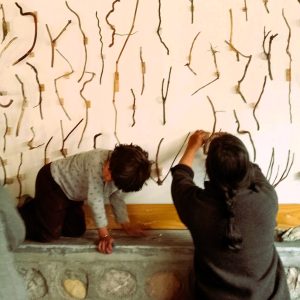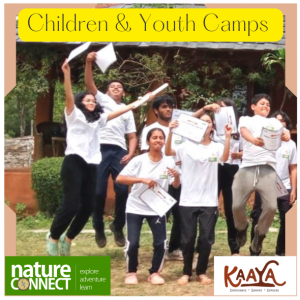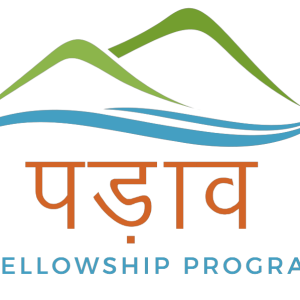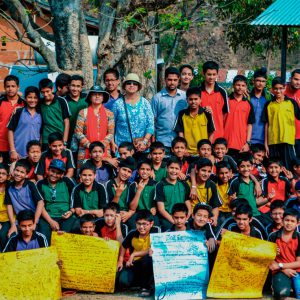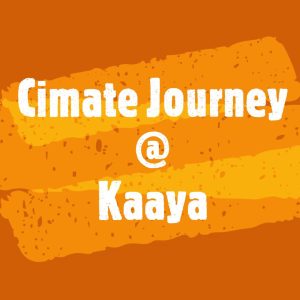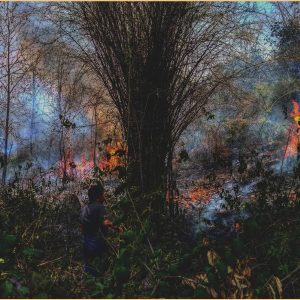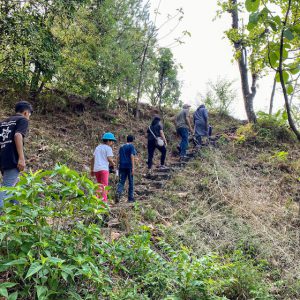In the larger pursuit of “development and growth”, many of us tend to lose our connection with nature, self, family, community, and the neighbourhoods. Somehow, we seem to forget that it is our immediate environment, the microcosm, the people, their habitat, soil, water, air, trees etc – sustain us and nurture life.
Kaaya evolved out of this realization of growing dis-connect from the things that really matters in life of an individual. The urban settings do make us a consumer, even of the education we get. Now when, there is access to knowledge, information, and media at our fingertips; It is the ability of our own faculties to absorb, reflect and respond is being put to test. Are we making right choices? Or are we increasingly getting overwhelmed by information overload in our capacity to ‘act’ despite the imminent crisis of sustainability around?
The beginning
It was in 2011, perhaps in some moment of inertia, largely to fulfil some curiosities as to how this rural-urban continuum work, lead to Kaaya. The idea was to just stir a little and see the emerging patterns and perhaps to re-imagine the possibilities of some sustainable living options.
Thus, Kaaya began as an experiment, a small parcel of land was purchased in a village far from the city in 2012.
The idea was to see how it evolves, there was no blueprint. The space was named as Kaaya, in Hindi it means ‘body’, the outer physical form wherein the person who visits/inhabits space, rubs off its soul. A small mud earth building was created using locally available material within the limited resources that we had. Slowly people began to visit and see, often exhibiting intent to do things that they feel are important. Slowly, it became Kaaya Learning Centre, a space for living, creating nature art, build, learn farming, or buying directly from farmers.
However, as we were evolving, we couldn’t help but notice that the river streams are drying up; land erosion looms large over sloping fields and the biodiversity is being lost gradually in our neighbourhoods. While this weighed in our minds, we began to imagine Kaaya as a ‘learning ground’, a place where one takes responsibility of its neighbourhoods. The idea of an eco-school began to take shape around the theme of ‘experience’, ‘engage’ and ‘express’ and we could continue…to be hands on, learning, doing, and sharing.
To imagine this happening on a day-to-day basis required some perseverance, will, some resources but most importantly ‘people’ a regular inflow of them, to keep us inspired. Ten years down the line, today, we feel, not only we could survive and sustain, but we have now solid base to leave something of value for the next generation to use.
The Approach
The approach we adopted was to go in the village without any project or blueprint in mind. Just to explore, without trying to define any problem but to seek out more, using appreciative enquiry.
Secondly, we decided to manage on personal reserve; to build upon existing resources using design thinking. We became a farmer, thinking like them, diversifying; minimizing risks, recycling & reusing, saving money; finding ways to survive and grow sustainably. What this all meant for us, was to become more grounded, creative, and openly share what we are trying to do. It is the intent, trust, and honesty combined with lots of innovative programming in collaborations, that begin to get urban visitors to kaaya- either for experiential learning or for eco-tourism.
Evolution
Kaaya bought urban visitors/ school kids to a village (not connected with tourism). It is the village that became a teacher, sharing how they grow food, take care of cattle, and engage with nature. They saw the light of appreciation in the young one’s eyes. Similarly, the neighbourhoods, whose kids, aspiring to migrate to cities wondered why the city people are coming to their village.
Kaaya connected both, the rural & the urban; In the process, urban consumers are getting sensitized to rural life; and their demand for rural products is inspiring village communities and artisans to produce more. Now, reverse migration has become a reality. We are now looking towards ways to channelize this energy.
Organization
As a social enterprise, Kaaya is designed to sustain, to continue doing what we love to do. Our business concept is straightforward. A Registered Company manages the campus’ the “hardware” (boarding & lodging as revenue streams). Irrespective of type of visitors (they could be families, workshop participants, tourists, guests, or school children), everyone is supposed to pay for the meals and accommodation at Kaaya. There is a small committed local team under women’s leadership, who handle logistics like accommodation, food, and community outreach independently. The Company structure not only sustain this team, but also help follow local laws and ordinances and preserve the spirit of the enterprise within team & community.
It is the Kaaya’s programming, or “software,” that makes it unique. A core group of urban enthusiasts, including us, design & support Kaaya programs. We also get volunteers or trained resources for certain activities, whose cost Kaaya bears, when it sees value for the neighbourhoods. All the non-profit (Registered Society) board members serve in advisory capacity only.
This social enterprise model provided us great flexibility to do innovative programming. During Covid times, when learning programs stopped, Kaaya adapted and began to host nature lovers/solitude seekers/ workcation clients, sustaining the operations team.
The Impact & growth potential
Within limited resources and purely using market mechanism, we have gradually begun to impact outdoors’s educational eco-system. On average, every year, we could get around 500 students coming from different parts of India and even abroad to receive practical and hands on-learning Please See Kaaya Eco-school
The scope of our programming as a ‘learning ground’ (9 villages, 3500 Ha land area, and 605 rural households), is most promising but unfortunately, we are not able leverage it sufficiently. That part later, but we could make a start with engagement of local community where students and volunteers undertake ‘live projects’ to address local issues in the neighbourhoods. At community level, we have taken first few steps towards a community supported agriculture that can be scaled up sustained by Kaaya alone.
At organizational level, Kaaya is still evolving as a campus. While we are still building it, we are using it as an incubation space to learn and execute some ideas of sustainability into practice. See Kaaya, plug’n’play. Now, since we can provide boarding and lodging facilities to at least 20 adults and 40 youths, the opportunities to hold different events and thematic workshops has opened.
Perhaps it’s time that we invest in creating an eco-system, where in social leaders/Mentors in different discipline can work together and channelize youth energy in sustainable ventures. The ‘Padav,’ a mentor-mentee program is one such initiative in this direction. See the ‘Padav‘ program


